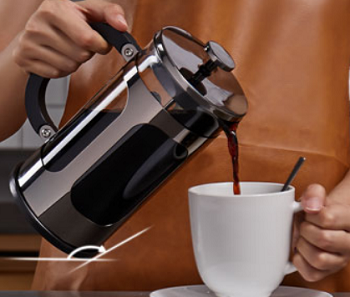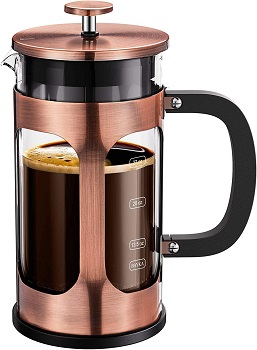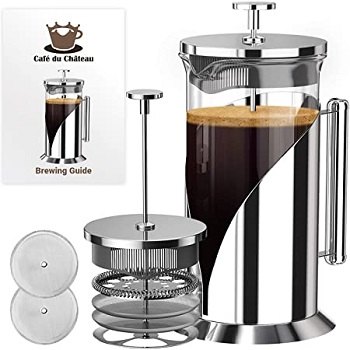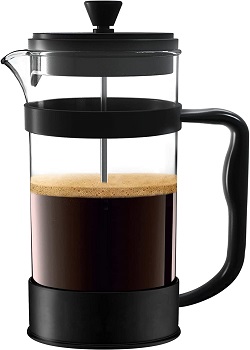As strange as it may seem, the French press actually was invented by an Italian designer named Attilio Calimani in 1929. The French press is often used for making coffee for a small group of people and for coffee enthusiasts who want to control the strength and flavor of their coffee.
Read on to find out what a French press is, how to use a French press at home, and what to look for when purchasing a French press.

What is a French Press?
A French press, also known as a cafetière, coffee press, coffee plunger, or press pot, is a type of coffee maker used to brew coffee by steeping ground coffee beans in hot water and then separating the liquid from the grounds by pressing a mesh filter through the mixture.
A French press typically consists of a cylindrical pot with a metal or nylon mesh filter in the lid, a metal or plastic plunger that fits tightly in the cylinder and presses the grounds to the bottom, and a separate decanter.
French press is a full immersion method, which means that the coffee grounds are fully submerged in the water, which allows for a strong and rich extraction. French press brewing is considered a manual method and it’s very popular among coffee enthusiasts.
You might also like to read: Aeropress vs. French Press
How Does a French Press Work?
A French press works by steeping coarsely ground coffee beans in hot water and then separating the liquid from the grounds by pressing a mesh filter through the mixture. Here’s the general process:
The French press method allows for more control over the brewing process, making it possible to brew coffee to a specific strength and taste. The full immersion technique allows the coffee grounds to fully steep and extract their flavors into the water, resulting in a rich and full-bodied cup of coffee.
How to use a French Press step-by-step?
Here’s a step-by-step guide on how to use a French press:
- Start by heating water to around 200°F (93°C) and grind your coffee beans to a coarse grind.
- Assemble your French press by placing the metal or nylon mesh filter in the lid and inserting the plunger.
- Place the ground coffee in the bottom of the French press and pour the hot water over it.
- Stir the mixture and let it steep for 4 minutes.
- After 4 minutes, press the plunger down to the bottom of the pot, separating the liquid coffee from the grounds.
- Pour the brewed coffee into a cup or carafe and enjoy it.
- Clean the French press by disassembling it and rinsing the parts with hot water.
You can adjust the strength of the coffee by varying the amount of coffee you use, the brewing time, or the temperature of the water. As well you can adjust the ratio of coffee to water according to your preference.
Keep in mind that the French press is a full immersion method, which allows for a strong and rich extraction, but also can make the coffee taste bitter if left too long.
What features should I look for in a French Press?
When looking for a French press, there are several features to consider:
- Material: French presses can be made of glass, stainless steel, or ceramic. Some French Presses are made with insulated walls and will retain heat better in your coffee than devices with non-insulated walls, but you generally will serve the coffee in your French press immediately, so insulation may not be a significant issue for you. Glass can be fragile and can retain heat less well than the other materials. Stainless steel and ceramic are more durable and retain heat better.
- Size: French presses come in different sizes, from small individual presses to large presses that can make multiple cups of coffee. Consider how much coffee you typically need to make and choose a size accordingly.
- Plunger: Look for a French press with a sturdy and durable plunger that can press the coffee grounds to the bottom of the pot effectively.
- Filter: French presses come with metal or nylon mesh filters. Metal filters are more durable, but nylon mesh filters are more effective in trapping fine grounds.
- Insulation: Consider a French press with double-walled insulation to keep your coffee hot for longer.
- Design: French presses come in different designs and colors, so you can choose one that matches your kitchen decor.
- Brand reputation: Look for a well-known brand with a good reputation for quality and customer service.
- Easy to clean: Look for a French press that is easy to disassemble and clean, and is dishwasher safe.
By considering these features you will be able to find a French press that suits your needs and preferences.
Best French Press
Best Seller: BAYKA French Press Coffee Maker

View Product on Amazon.com
The BAYKA French Press Coffee Maker is moderately priced, and made of high-quality materials, including borosilicate glass to resist the thermal shock of sudden temperature changes. With a specially thickened bottom to maintain temperature and with stainless steel or stainless steel and copper framework. Carafe holds a full 34 oz. of coffee and has 4 levels of filtration for superior flavor. Completely disassembles for easy cleaning.
Best Warranty: Cafe Du Chateau French Press Coffee Maker

View Product on Amazon.com
Featuring a lifetime replacement policy, this Cafe Du Chateau French press has attractive modern styling executed in Stainless Steel and thermal shock resistant borosilicate glass. Included 4 levels of filtration. Surpasses al European Commission and U.S.F.D.A. food safety standards. 34 oz. carafe.
Most Affordable: Utopia Kitchen 34 Ounce French Press Espresso and Tea Maker

View Product on Amazon.com
The Utopia French press features a large 34 oz (1000 ml) heat resistant borosilicate glass carafe in an insulated plastic frame. Features a triple stainless-steel filter. Very affordably priced, this French press makes great coffee at an affordable price.
Final Thoughts
There are several reasons why a French Press might be the right choice for you.
- Taste: French press coffee is known for its rich, full-bodied flavor. The long steeping time and the metal filter that allows the oils from the coffee beans to pass through, resulting in a stronger and more flavorful cup of coffee.
- Control: French press gives you the control over how strong you want your coffee to be. You can adjust the steeping time, the water temperature and the grind size to suit your taste preferences.
- Simplicity: A French press is very easy to use. You only need ground coffee and hot water to make a delicious cup of coffee.
- Durability: The French press is made of durable materials such as glass, stainless steel or ceramic, which can last for a long time with proper care.
- Cost effective: French presses are relatively inexpensive, and you don’t need to buy paper filters or pods, which can save you money in the long run.
- Portable: French press is lightweight and easy to transport, making it a great option for camping, traveling, or enjoying coffee on the go.
Overall, the French press is a good option for those who want to make a delicious, full-bodied coffee at home, and want to have control over the brewing process.
FAQ’s
Q1: What is the right grind size for a French press?
The right grind size for a French press is a coarse grind. This allows the coffee grounds to be large enough to be trapped by the press filter, but small enough to release flavor into the water. A coarse grind is similar in size to coarse sea salt or coarse sand.
Q2: What the correct ratio of coffee to water in a French press?
The general rule of thumb for the ratio of coffee to water in a French press is 1:15. This means that for every 1 gram of coffee, you should use 15 grams of water. So, for example, if you are using 30 grams of coffee, you should use 450 grams of water (30 x 15 = 450).
However, this ratio can be adjusted to taste. You can experiment with different ratios to find the strength and taste that you prefer.
Q3: What is the best coffee to use in a French press?
The best coffee to use in a French press is a medium to dark roast, whole bean coffee.
French press brewing requires a coarse grind, which is best achieved with whole bean coffee. Medium to dark roasts have a stronger flavor profile and can stand up well to the full immersion brewing method of a French press. Whole bean coffee is also fresher than pre-ground coffee, which can lead to a better taste.
Additionally, you may consider using high-quality Arabica beans, which are known for their complex and nuanced flavor profile, rather than lower-quality Robusta beans. It also depends on personal preference you can experiment with different types of beans to find the one that you like best.
You might also like to read: Which coffee beans should I buy?
Q4: How long do you let coffee brew in a French Press before drinking it?
The recommended brew time for a French press is around 4 minutes. This allows the coffee grounds to fully steep and extract their flavors into the water. Once the 4 minutes have passed, you should press down the plunger to separate the coffee grounds from the liquid.
It is recommended to pour the coffee immediately after pressing it to avoid over-extraction which can make the coffee taste bitter.